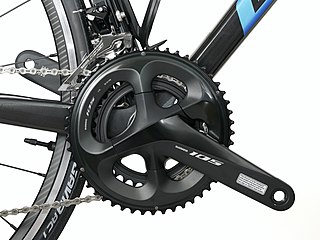
Standard anatomical terms of location are used to unambiguously describe the anatomy of animals, including humans. The terms, typically derived from Latin or Greek roots, describe something in its standard anatomical position. This position provides a definition of what is at the front ("anterior"), behind ("posterior") and so on. As part of defining and describing terms, the body is described through the use of anatomical planes and anatomical axes.

The crankset or chainset, is the component of a bicycle drivetrain that converts the reciprocating motion of the rider's legs into rotational motion used to drive the chain or belt, which in turn drives the rear wheel. It consists of one or more sprockets, also called chainrings or chainwheels attached to the cranks, arms, or crankarms to which the pedals attach. It is connected to the rider by the pedals, to the bicycle frame by the bottom bracket, and to the rear sprocket, cassette or freewheel via the chain.

Carnage is a supervillain appearing in American comic books published by Marvel Comics, usually as an adversary of Spider-Man and the archenemy of Venom. The character made its first appearance in The Amazing Spider-Man #361, and was created by writer David Michelinie and artist Mark Bagley, although the first published artwork of Carnage was penciled by Chris Marrinan.

The Lizard is a character appearing in American comic books published by Marvel Comics. Created by Stan Lee and Steve Ditko, he first appeared in The Amazing Spider-Man #6 as an enemy of the superhero Spider-Man. While the character has retained this role throughout most of his subsequent appearances, he has also been portrayed as a tragic antihero and occasional ally of Spider-Man. Connors is sometimes an ally of Spider-Man just as himself, and not necessarily as his alter ego.

The Pholcidae are a family of araneomorph spiders. The family contains more than 1,800 individual species of pholcids, including those commonly known as cellar spider, daddy long-legs spider, carpenter spider, daddy long-legger, vibrating spider, gyrating spider, long daddy, and skull spider. The family, first described by Carl Ludwig Koch in 1850, is divided into 94 genera.

General Nicholas Joseph "Nick" Fury is a fictional character appearing in comic books published by Marvel Comics' Ultimate Marvel section as a different version of Nick Fury. He has a substantial presence in all the Ultimate Marvel comics, appearing first in Ultimate Marvel Team-Up and Ultimate X-Men and later reappearing regularly in Ultimate Spider-Man and finally securing a regular, recurring role as the general of S.H.I.E.L.D. and the leader of the Ultimates, a re-imagining of the Avengers. This character was designed to look like Samuel L. Jackson, who later went on to portray the character in the Marvel Cinematic Universe; the recognizability of the MCU version later led Marvel to retire the original Earth-616 character with his son.

Caladenia, commonly known as spider orchids, is a genus of 350 species of plants in the orchid family, Orchidaceae. Spider orchids are terrestrial herbs with a single hairy leaf and a hairy stem. The labellum is fringed or toothed in most species and there are small projections called calli on the labellum. The flowers have adaptations to attract particular species of insects for pollination. The genus is divided into three groups on the basis of flower shape, broadly, spider orchids, zebra orchids and cowslip orchids, although other common names are often used. Although they occur in other countries, most are Australian and 136 species occur in Western Australia, making it the most species-rich orchid genus in that state.

The Octopus is a type of amusement ride in the shape of an octopus. Five to eight arms attached to a central axis of rotation and move up and down in a wavelike motion, while cars at the end of the arms, either attached directly to the arm or fixed on spinning crosses, spin freely or stay in place, depending on the exact type of ride. Each Octopus ride has the arms attached the middle of the ride. The middle or centric of the ride will move somehow. Most octopus rides require guests to be at least 42 inches to ride without an adult; smaller children must have an adult with them. This is a regular at the annual AGS and AHS fairs in Ateneo de Manila University

The spider genus Aname is endemic to Australia, with one species found only on Tasmania. It contains the black wishbone spider, A. atra.

Scorpion is a fictional character appearing in American comic books published by Marvel Comics. She first appears in Amazing Fantasy #7 and was created by Fred Van Lente and Leonard Kirk.

Ultimate Requiem is a series of comic books published by Marvel Comics. It takes place in the Ultimate Universe following the events of Ultimatum. The X-Men and Fantastic Four stories were published as one shots, while the Spider-Man story was published as a two-issue with the name Ultimatum: Spider-Man Requiem #1 and #2 limited series. The books serve as an epilogue to each of the Ultimate Universe's three core titles, which were all canceled following Ultimatum. The issues in the series are the last ones published as Ultimate Marvel comic books before the imprint was relaunched as Ultimate Comics.

Spiders are air-breathing arthropods that have eight legs, chelicerae with fangs generally able to inject venom, and spinnerets that extrude silk. They are the largest order of arachnids and rank seventh in total species diversity among all orders of organisms. Spiders are found worldwide on every continent except for Antarctica, and have become established in nearly every land habitat. As of August 2022, 50,356 spider species in 132 families have been recorded by taxonomists. However, there has been debate among scientists about how families should be classified, with over 20 different classifications proposed since 1900.

Hooks is a term in grappling martial arts that generally refers to the use of careful positioning of a practitioner’s feet and legs to control and manipulate the movement or position of their opponent. One of the most common uses of hooks is in the back control position to prevent escape. However, a practitioner may alternatively use hooks to defend, sweep, or attack their opponent.
Chenistonia is a genus of spiders in the family Anamidae. It was first described in 1901 by Henry Roughton Hogg. As of 2020, it contains 8 species, all from Australia.

The BDC 10 was a cluster bomb used by the Luftwaffe during World War II.
Chenistonia earthwatchorum is a species of mygalomorph spider in the Anamidae family. It is endemic to Australia. It was described in 1984 by Australian arachnologist Robert Raven.
Chenistonia tropica is a species of mygalomorph spider in the Anamidae family. It is endemic to Australia. It was described in 1984 by Australian arachnologist Robert Raven.
Chenistonia hickmani is a species of mygalomorph spider in the Anamidae family. It is endemic to Australia. It was described in 1984 by Australian arachnologist Robert Raven.
Chenistonia montana is a species of mygalomorph spider in the Anamidae family. It is endemic to Australia. It was described in 1984 by Australian arachnologist Robert Raven.
Chenistonia maculata is a species of mygalomorph spider in the Anamidae family. It is endemic to Australia. It was described in 1901 by British arachnologist Henry Roughton Hogg.














